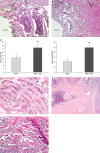Effect of a local, one time, low-dose injection of zoledronic acid on titanium implant osseointegration in ovariectomized rats
- PMID: 27695483
- PMCID: PMC5016583
- DOI: 10.5114/aoms.2016.61908
Effect of a local, one time, low-dose injection of zoledronic acid on titanium implant osseointegration in ovariectomized rats
Abstract
Introduction: Local application of bisphosphonates has been proven to be safer than systemic administration to promote implant fixation. The objective of this study was to introduce such a simple, convenient and efficient method to enhance titanium (Ti) implant osseointegration in ovariectomized (OVX) rats.
Material and methods: Twenty female Sprague-Dawley rats sequentially underwent bilateral ovariectomy and tibia implantation, and injection of 30 µg/implant zoledronic acid (ZOL) at the site of implantation was performed. At the end of the study, the tibiae, mandibles, femurs and vertebrae were harvested for dual energy X-ray absorptiometry, histology and micro-computed tomography examination.
Results: Ovariectomized rats showed poor bone density, bone mass and trabecular microstructure. OVX + ZOL rats were characterized by significantly improved peri-implant bone area (1.72-fold), bone contact (2.30-fold), bone mineral density (1.57-fold) and bone mineral content (1.67-fold), as well as moderately increased bone volume to total volume ratio (1.34-fold), percentage osteointegration (1.54-fold), connectivity density (1.45-fold), and trabecular number (1.43-fold), but decreased trabecular separation (57.69%) when compared with the control levels (p < 0.05). No histological signs of jaw osteonecrosis were observed in the rats treated with ZOL, and there was no significant difference between the OVX group and OVX + ZOL group in the bone mass of the mandible, femur and 5th lumbar vertebra (p > 0.05). In addition, the overproduction of osteoporosis-induced advanced glycation end-products (AGEs) was completely prevented by local treatment with 30 µg/implant ZOL.
Conclusions: A local, one time, low-dose injection of ZOL at the site of implantation is able to promote the osseointegration of Ti implants following postmenopausal osteoporosis, and this action may be partly mediated by inhibition of the osteoporosis-induced AGE overproduction in the bone marrow.
Keywords: advanced glycation end products; bisphosphonate; implant; osteoporosis.
Figures





Similar articles
-
Effect of combined local treatment with zoledronic acid and basic fibroblast growth factor on implant fixation in ovariectomized rats.Bone. 2009 Feb;44(2):225-32. doi: 10.1016/j.bone.2008.10.054. Epub 2008 Nov 12. Bone. 2009. PMID: 19056525
-
Zoledronic acid enhances bone-implant osseointegration more than alendronate and strontium ranelate in ovariectomized rats.Osteoporos Int. 2013 Jul;24(7):2115-21. doi: 10.1007/s00198-013-2288-7. Epub 2013 Feb 7. Osteoporos Int. 2013. PMID: 23389695
-
Effect of zoledronate acid treatment on osseointegration and fixation of implants in autologous iliac bone grafts in ovariectomized rabbits.Bone. 2012 Jan;50(1):119-27. doi: 10.1016/j.bone.2011.10.011. Epub 2011 Oct 17. Bone. 2012. PMID: 22023930
-
Effect of systemic administered zoledronic acid on osseointegration of a titanium implant in ovariectomized rats.J Craniomaxillofac Surg. 2014 Oct;42(7):1106-11. doi: 10.1016/j.jcms.2014.01.039. Epub 2014 Jan 22. J Craniomaxillofac Surg. 2014. PMID: 24530079
-
Microarchitectural changes in the mandibles of ovariectomized rats: a systematic review and meta-analysis.BMC Oral Health. 2019 Jun 26;19(1):128. doi: 10.1186/s12903-019-0799-0. BMC Oral Health. 2019. PMID: 31242880 Free PMC article.
Cited by
-
Microcirculatory consequences of limb ischemia/reperfusion in ovariectomized rats treated with zoledronic acid.J Orthop Surg Res. 2019 Apr 4;14(1):95. doi: 10.1186/s13018-019-1117-x. J Orthop Surg Res. 2019. PMID: 30947735 Free PMC article.
-
Beneficial effect of pristimerin against the development of osteoporosis in ovariectomy-induced osteoporosis rats by the RANKL/TRAF6/NF-κB pathway.Arch Med Sci. 2019 Jul 22;18(6):1650-1658. doi: 10.5114/aoms.2019.86816. eCollection 2022. Arch Med Sci. 2019. PMID: 36457960 Free PMC article.
-
Anabolic and antiresorptive actions of locally delivered bisphosphonates for bone repair: A review.Bone Joint Res. 2018 Nov 3;7(10):548-560. doi: 10.1302/2046-3758.710.BJR-2018-0015.R2. eCollection 2018 Oct. Bone Joint Res. 2018. PMID: 30464835 Free PMC article.
-
Effect of lycopene on titanium implant osseointegration in ovariectomized rats.J Orthop Surg Res. 2018 Sep 17;13(1):237. doi: 10.1186/s13018-018-0944-5. J Orthop Surg Res. 2018. PMID: 30223885 Free PMC article.
-
Histomorphometric Evaluation of Peri-Implant Bone Response to Intravenous Administration of Zoledronate (Zometa®) in an Osteoporotic Rat Model.Materials (Basel). 2020 Nov 20;13(22):5248. doi: 10.3390/ma13225248. Materials (Basel). 2020. PMID: 33233722 Free PMC article.
References
-
- Munhoz EA, Bodanezi A, Cestari TM, et al. Long-term rabbits bone response to titanium implants in the presence of inorganic bovine-derived graft. J Biomater Appl. 2012;27:91–8. - PubMed
-
- Jacobi-Gresser E, Huesker K, Schütt S. Genetic and immunological markers predict titanium implant failure: a retrospective study. Int J Oral Maxillofac Surg. 2013;42:537–43. - PubMed
-
- Hosoi T. Genetic aspects of osteoporosis. J Bone Miner Metab. 2010;28:601–7. - PubMed
LinkOut - more resources
Full Text Sources
Other Literature Sources
